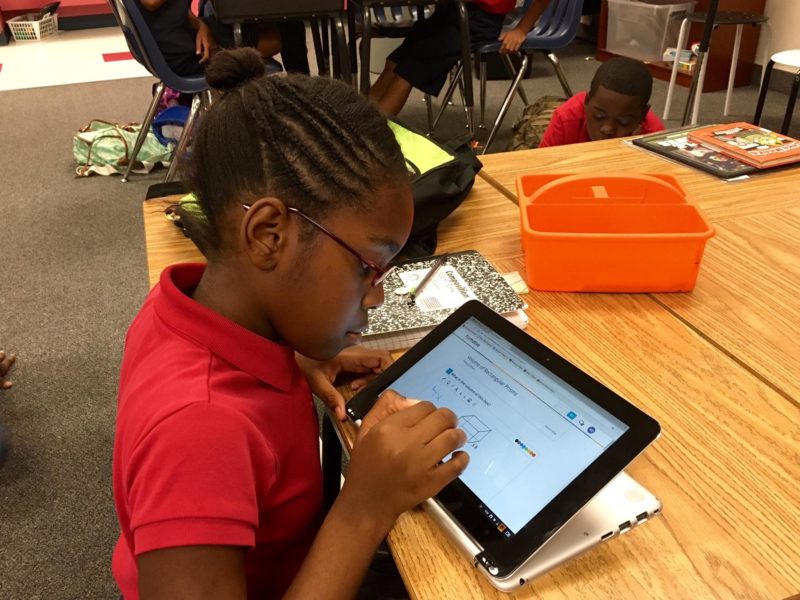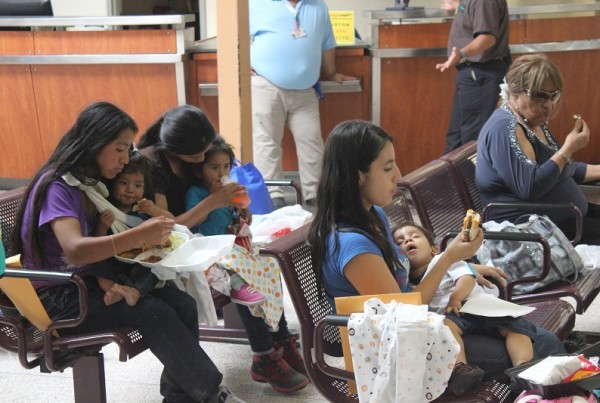From KERA News:
Just about everyone is using technology, and kids are practically experts. The issue for teachers is how to get kids to use these digital tools effectively in the classroom.
KERA visited one elementary school in the Carrollton-Farmers Branch district that’s finding technology can help students learn.
At McWhorter Elementary School, fifth graders in a math and science class are piecing together colorful plastic, Lego-like cubes on their desks.
They’re building geometric shapes and mimicking what they see on their laptop screens for an online quiz. Jayla Parker, 10, looks at the image of a rectangular prism and reads a question out loud.
“Ms. Smith bought a cube-shaped box to store books. The bottom of the box is the square shown. What is the volume of the box?”
Jayla and her classmates work through the problems on their Chromebooks and submit their answers online. Their teacher, Klarissa Cardenas, created the quiz through anonline program for educators called Nearpod.
“After they submit it, I get a big report and it’ll tell me which kids missed the most questions,” Cardenas said. “It’ll give me a grade. I can click on different questions and it’ll tell me how many students, percentage-wise, missed this one so that way as a teacher I know tomorrow I can go back and I can say ‘OK, these are the type of questions we can really focus on.’ ”
Cardenas says this digital approach is better for her students. She says they already love using devices like laptops and tablets, so they’re more engaged when they use them in class.
The teachers benefit, too. They don’t have to spend extra time grading papers at home after school hours.
“As a teacher it gives me more time to go back and look and it gives me more time to assess them and I can go back and help them to see better what they need,” Cardenas said.
More educators are using digital tools with their students
The University of Texas at Arlington offers an online course for teachers on how to best use emerging technology in the classroom. More than 3,100 people from 139 countries took the class.
Peggy Semingson is associate professor of curriculum and instruction at UTA. She consulted with Andrew Berning, a K-12 analytics research scientist, to help develop the course.
“One idea that’s really been emerging lately is the idea of one-to-one initiatives,” Semingson said. “So where students as young as kindergarten are able to use their own iPad or they have their Chromebook, and they’re able to work at their own pace using that device.”
Semingson also said educators should tailor the technology to help students who need it the most — students with learning disabilities or students who are learning English.
But she warns teachers should be mindful of how often devices are used in the classroom.
“Too much screen time can be detrimental if kids aren’t interacting with real people so to speak and getting oral language development,” she said. “One of the best ways for kids to learn is to for them to be read [and] to like lap reading.”
At McWhorter Elementary, Principal Yanet Cardoza encourages her teachers to use laptops and tablets and online programs in the classroom. Like Semingson, she also wants teachers to use technology wisely.
“I think the biggest thing is to use technology to enhance learning,” Cardoza said. “If it’s something that is just going to be something you can do with pencil and paper then maybe that’s not the best use of that technology tool.”
Cardoza said she doesn’t want students to just search for definitions on Google. She also tells teachers to have a Plan B if the technology they’re using fails or freezes, or the power goes out.
“You know, it’s OK to be nervous at first,” Cardoza said. “But if you just learn more about it, you’d be surprised about how comfortable the kids are.”
Back in the classroom, fifth-grader Naomi Ette uses her fingers to write numbers and draw shapes on a Chromebook. She said it’s her first time using the device to solve math problems.
“It’s more funner because you get to do it by yourself,” Ette said. “And it’s all technology and most students like technology.”
Naomi said doing math this way isn’t just fun, it’s also helping her learn.














